Earlier this year, Rivian expanded its plant in Normal, Illinois by nearly 20% to manufacture its Enduro drive unit. It’s an about-face from the drive units supplied by Bosch in Rivian’s Quad-Motor models, and should help mitigate the bottlenecks to ramping production of the R1T adventure pickup truck, R1S three-row SUV, and EDV electric delivery van.
Equipped in the EDV and Rivian’s new Dual-Motor models, the Enduro drive unit was designed and developed in house to be more efficient, less expensive, and better insulated from supply chain shocks that quaked the industry during the pandemic, right as Rivian began production in 2021.
Rivian bought the forlorn Mitsubishi plant for $16.5 million in 2017 and now churns out both Quad Motor and Dual Motor models. A recent tour of the 4-million-square-foot facility showcased the 620,000-square-foot expansion needed to produce Enduro, and how that drive unit will enable production for a less expensive R2 platform, slated to be developed at a new plant in Georgia as early as 2026.
For now, its Normal plant is on pace to manufacture 52,000 Rivians this year, with a target of 150,000 units eventually. Its passenger vehicles will be offered with either the four motors developed by Bosch in the Quad Motor setup or the Normalized [ahem] Dual Motor setup. Since the beginning of this year, the EDV exclusively uses the Enduro single-motor drive unit on the front axle.
Here’s an overview of the Enduro drive unit and Rivian’s Dual-Motor models.

Rivian plant in Normal, Illinois, manufacturing its Enduro drive unit
Rivian Dual-Motor availability
-
Dual-Motor models sold with Standard, Large, and forthcoming Max Pack battery sizes
-
Performance Dual-Motor sold with Large and Max Packs (available this fall)
-
Standard Pack to be made with lithium iron phosphate cells, but has no release date
-
Every Quad-Motor to date has been sold with the Large Pack; no other pack size is offered
As of now, Rivian has only sold the R1T and R1S as Quad-Motor models with the Large Pack. Orders for the R1T Dual-Motor and Performance Dual-Motor with the Max Pack are open. The R1S Max Pack option will be offered on the configurator this fall.
The Standard Pack holds the most promise in terms of efficiency. With its LFP chemistry and the Enduro drive unit, the EDV was 35% more efficient than previous builds with the 135-kwh battery pack and the Bosch motor unit, according to Rivian CEO RJ Scaringe. First deliveries of models with the Standard Pack are expected early in 2024.
It remains to be seen how long Rivian will keep offering the more expensive Quad-Motor setup.
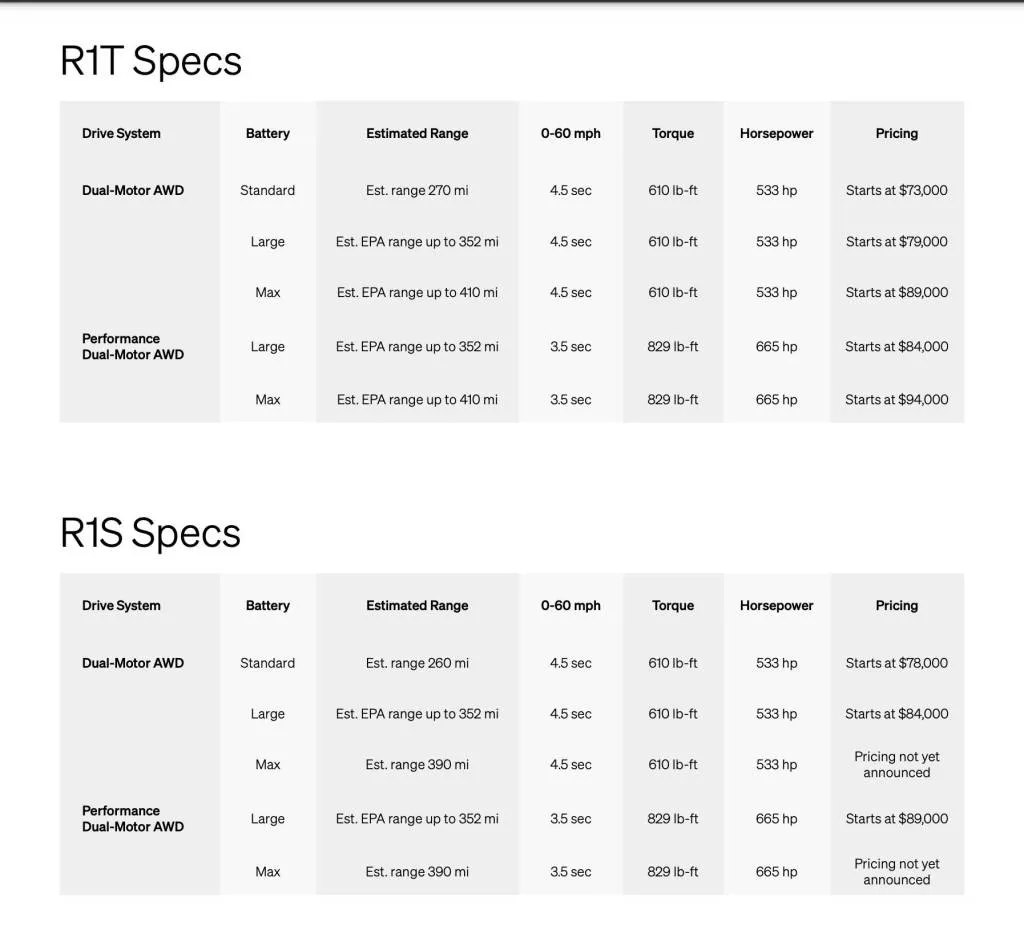
Rivian R1T and R1S Dual-Motor spec chart
Rivian Dual Motor pricing
-
R1T Dual-Motor Standard Pack $74,800, including $1,800 destination
-
R1T Dual-Motor Large Pack adds $6,000 to $80,800
-
R1T Dual-Motor Max Pack costs $16,000 more to $90,800
-
Performance Dual-Motor Large Pack adds $5,000 to $85,800
-
Performance Dual-Motor Max Pack costs $95,800
-
R1T Quad-Motor Large Pack costs $88,800
The Max Pack upgrade represents the biggest jump in Rivian’s pricing structure, at $16,000. That makes both the Dual-Motor and Performance Dual-Motor more expensive than the Quad Motor.
The R1S three-row SUV is $5,000 more across the board, but the Max Pack comes online in the configurator this fall.

Rivian Enduro drive unit components
Rivian Quad-Motor vs. Dual-Motor design
-
Enduro Dual-Motor drive units weigh about 220 pounds
-
Quad-Motor rear drive unit weighs 320 pounds; Quad front weights 275 pounds
-
Enduro drive units are smaller, lighter, and more efficient
The mechanical difference between the Rivian Enduro drive unit and the Bosch unit comes down to size, cost, and efficiency. The Quad-Motor units house two motors and two gear sets in each unit, resulting in larger and longer casings. The rear-axle quad unit measures 135 mm long, while the front measures 110 mm long, according to Mason Verbridge, Rivian’s principal drive unit engineer. With mounts and high voltage cables, the rear-axle quad unit weighs about 320 pounds, and about 275 pounds up front.
By contrast, each Enduro unit weighs about 220 pounds. For Dual-Motor models that adds up to a weight savings of about 155 pounds. Every pound matters, even for an R1T Dual Motor Performance with a curb weight of about 6,750 pounds.
“There are fundamental physics advantages of just having one motor, one gearset, one basically rotating assembly,” Verbridge explained. “With a Quad you have two gear sets, two motors, all the bearings, all the windage losses of double that rotating assembly.”
Rivian designed and housed the inverter, motor, and gearbox in one casing, instead of separate sealed entities that get bolted together. Essentially, there are fewer parts to assemble, with less weight and less redundancy.
“Basic philosophy is once you solve requirements of all three subsystems then it makes everything much easier,” he explained.
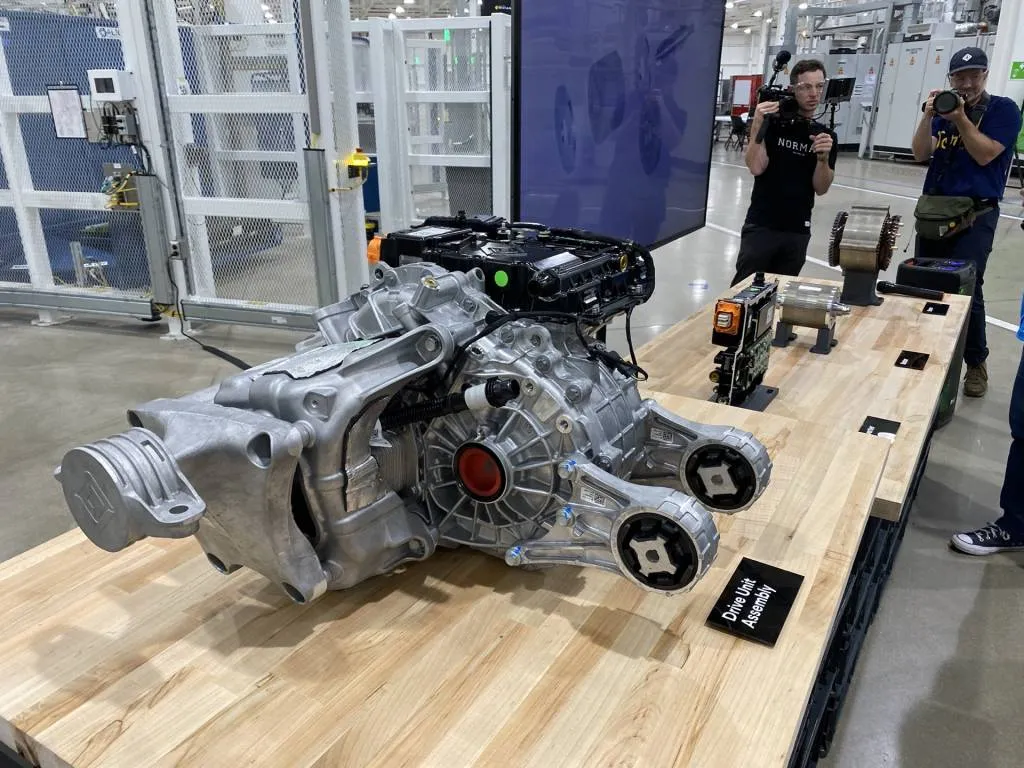
Rivian Enduro drive unit assembly
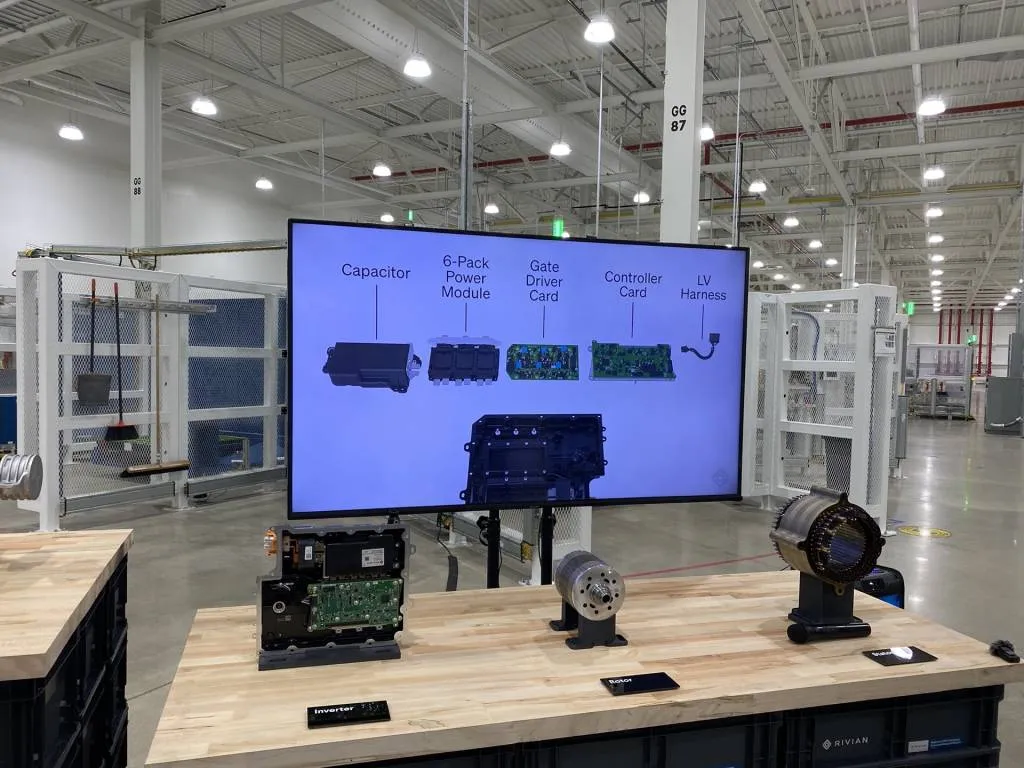
Rivian Enduro drive unit inverter components
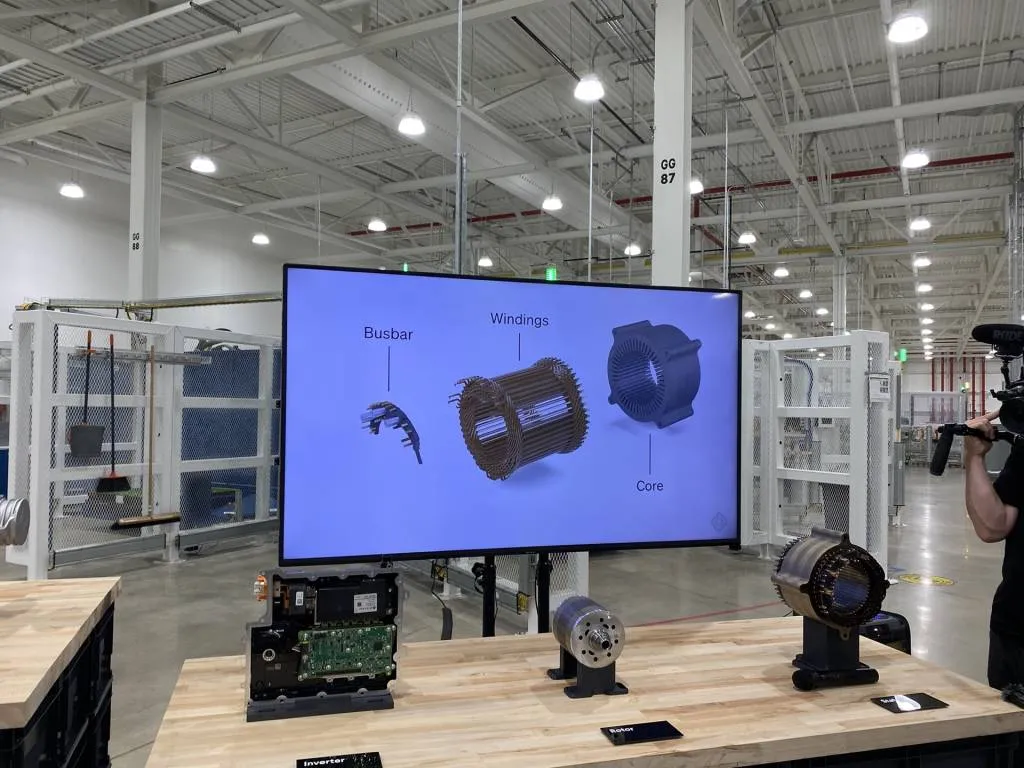
Rivian Enduro drive unit stator components
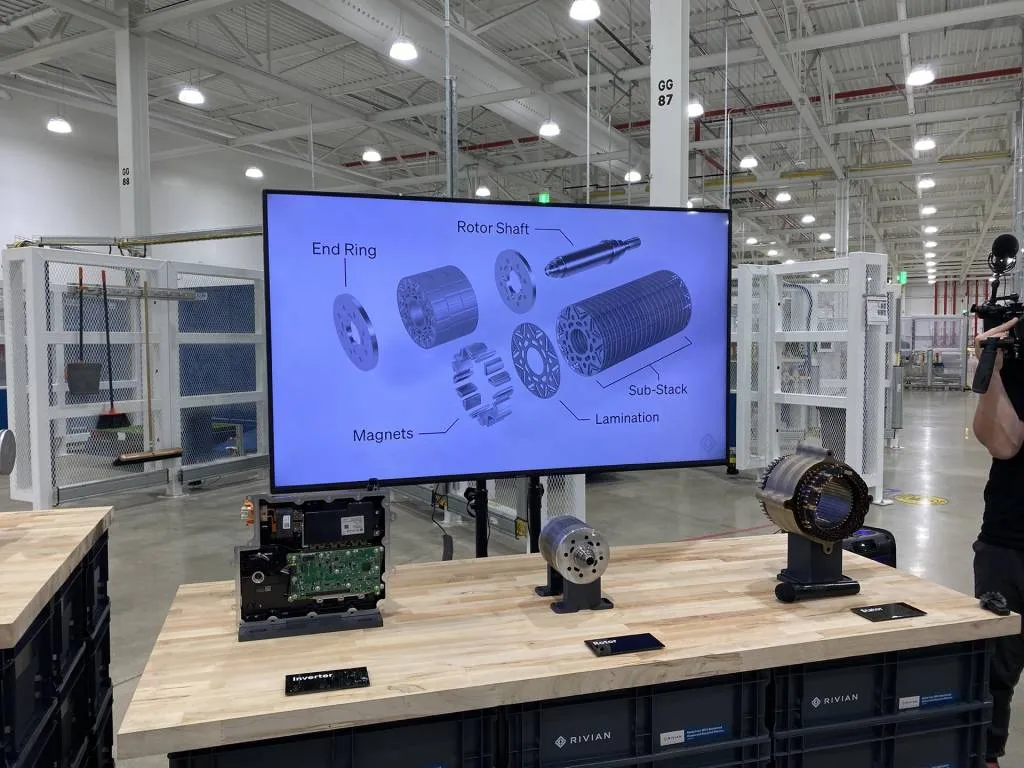
Rivian Enduro rotor components
The core benefit of developing its own motors comes from the knowledge of how to program and optimize the motors from the start, instead of setting a target for what Rivian wanted the motors to do from Bosch then adjusting it back and forth to get it right for the specific use case.
For example, the inverters converting DC from the battery to AC for the motor differ based on the axle in Dual-Motor models. There’s a silicon carbide power module for the front unit inverter but a less-expensive silicon power module for the rear inverter. Silicon carbide has an efficiency of more than 99% compared to about 98% efficiency with silicon, according to Silva Hiti, Rivian senior director of electric power conversion. At peak efficiency, Hiti said this translates to 3.5% more range than if Rivian used silicon power modules for both inverters. It makes more sense to use more efficient (but more expensive) silicon carbide on the front unit that is used more in Dual-Motor models.
“By the time we came to Enduro we understood those use cases super well,” Verbridge said. “If you know exactly what the motor needs to do, you know where you can really dial in and prioritize being efficient in these areas on that operating map.”

Rivian plant in Normal, Illinois, manufacturing its Enduro drive unit
Rivian Quad-Motor vs. Dual-Motor drive modes
-
Every Rivian passenger vehicle has All-Purpose, Snow, All-Terrain, and Towing modes
-
Performance Dual-Motor adds Sport mode
-
Quad-Motor models add Conserve as well as All-Terrain sub-modes, such as Drift, Rally, Rock Crawl, Soft Sand
Unlike the Quad-Motor setup, the Rivian Dual-Motor does not have a Conserve mode. Instead, the default All-Purpose mode decouples the rear axle to run as a front-wheel-drive truck for greater efficiency in most scenarios. But the rear axle powers on-demand as well, not just with a button push. So if the driver floors it, the torque bias can shift from 100/0 to about 45/55 in a blink.
All-Purpose in the Quad-Motor remains connected, unless Conserve mode is selected. So the default All-Purpose mode in the Dual serves a similar function as Conserve in the Quad as the most efficient setting, limiting parasitic losses. Rivian would not say if all that torque on the front axle of the Performance Dual-Motor will chew through tires as excessively as Conserve mode does in the Quad, but it shouldn’t be as dramatic.
The Enduro final drive ratio is lower than the Quad, which is 12.9:1 at all four corners. The Dual-Motor has a final gear ratio of 11.04:1 in the front and 13.7:1 in the rear. Since it disconnects the rear axle and doesn’t have the extra surge of power from Sport mode—in most driving scenarios except when flooring it—there shouldn’t be as much uneven wear on the tires as there is in Conserve mode in the Quad.
Then there’s Sport mode in the Performance Dual-Motor. See more below.
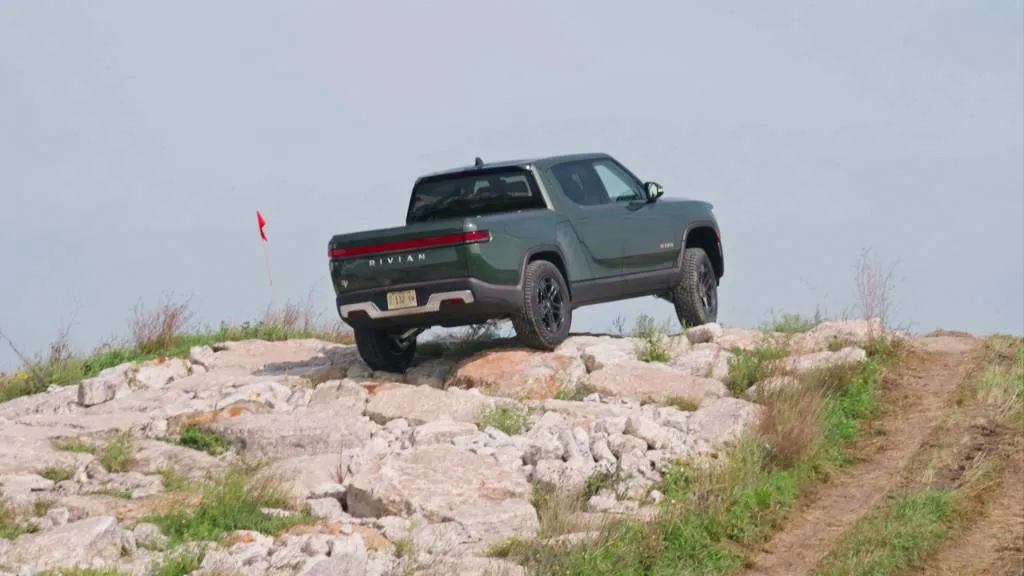
Rivian plant in Normal, Illinois, manufacturing its Enduro drive unit
Rivian Dual-Motor performance
-
R1T Dual-Motor makes 533 hp, 610 lb-ft of torque; it hits 60 mph in 4.5 seconds
-
R1T Performance Dual-Motor makes 665 hp, 829 lb-ft; it hits 60 mph in 3.5 seconds
-
R1T Quad-Motor makes 835 hp, 908 lb-ft; hits 60 mph in 3.0 seconds
In back-to-back testing on an oval loop of the R1T Performance Dual-Motor and the R1T Quad Motor, the Performance Dual-Motor had a slight lag before the full power came on, but its surge to 60 mph in 3.5 seconds was still enough to drop my gut. There’s plenty of power, especially for a vehicle this size and shape. We did not get to test the standard Dual-Motor. Consider the Performance Dual-Motor more than a half step to the quad.
In Sport mode, both drive units remain engaged.
In a brief off-road demo, the Dual-Motor tackled the same obstacles with the same competency as the Quad Motor. The bigger difference in handling and four-wheel drive in the Quad instead of all-wheel drive in the Dual comes from how torque gets routed to the wheels. The Dual relies on brake-based torque vectoring, whereas the Quad utilizes the four motors to apportion torque to each wheel. It’s a better experience in spirited on-road driving and more daring off-road scenarios, but the Dual is so capable that only in back-to-back testing does it feel a grade lower.

Rivian plant in Normal, Illinois, manufacturing its Enduro drive unit
Rivian Quad-Motor vs. Dual-Motor towing
-
R1T tows up to 11,000 pounds with either drive system
-
R1S tows up to 7,700 pounds with either drive system
-
Expect a 45% battery range drop when towing, subject to many variables
Both drive systems tow the same amount: The R1T tows up to 11,000 pounds; the R1S tows up to 7,700 pounds. Towing comes standard with a 7-pin harness. It doesn’t have a load-distributing hitch, but Rivian says trailer sway mitigation is built into the software. The brake controller activates from the right steering wheel control or in the touchscreen.
We rode along in an R1T Performance Dual-Motor towing a 9,800-pound electric delivery van on a trailer. It was huge, looming over us, as if a cinder block could be a main mast. The pull was noticeable, as was the wobble with some wind on an overpass. Power was plentiful, braking never felt taxed, but the sheer size of the van on the trailer was apparent throughout the demo. I can’t imagine any other towing scenarios with that kind of aero profile.
While in park, it can be adjusted to the low ground clearance setting of 10.1 inches for increased efficiency on the highway, or remain in the standard 11.3-inch setting. Drivers can also adjust the damping between Soft and Stiff.
Rivian estimates that putting it into Tow mode will lower the estimated range by 45%, but there are so many variables at play that it’s a guesstimate based on driving profile, trailer weight, and road conditions, among other things. One of Rivian’s key advantages is how accurately it calculates estimated range, and a pending towing update expected in the next two months should apply that accuracy to towing. It will allow you to enter the trailer weight or the system will calculate the trailer weight to create different trailer profiles, and the range estimates will reflect that profile and/or weight and learn over time to provide more accurate estimates. The update will also factor in more traction-based scenarios by enabling drivers to tow in Off-road and Snow mode in both Quad- and Dual-Motor models. The update will also activate bed camera angles for the R1T.
For tow mirrors, look to the aftermarket. For most other things, Rivian appears to have it covered.
–
Rivian provided Green Car Reports a night of lodging and a factory visit for an up-close look at the Enduro drive unit.

